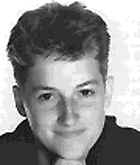| SarahKane |
 |
thenotionofcruelty |
| SarahKane |
 |
thenotionofcruelty |
| The Notion of Cruelty in the Work of Sarah Kane by Gaëlle Ranc When Blasted was performed at la Comédie de Saint-Etienne, I did not see it but my mother did. I remember that when she came back home after the play, and told me the story explaining that someone had his eyes bitten off and that a baby was eaten, I was horrified. I told her that I did not see the point of showing gratuitous violence on stage. But she replied by reminding me that this kind of thing really happens in times of war. When I read Blasted, it surprised me: I was expected to be shocked but I wasn't, and I realised that its violence had been exaggerated. I could see that there was something else beyond the violence, that the author was telling us something; but at the time I could not really define what it was. And when I read Cleansed, it clearly appeared to me that the violence of Kane's plays was a metaphor. Two years later, I saw Crave, directed by Daniel Benoin, which left me speechless and with the longing to read the play. One performance was not enough to catch the whole meaning of it, I felt this text had to be read and re-read. Sarah Kane was a talented playwright, she managed to create a new kind of theatre and the sensitive spectator will be able to see the beauty of her work and its moral awareness. As Dominic Dromgoole said, she had 'an acute understanding, both philosophical and quotidian, of the fabric of the modern world' and 'if she [leaned] towards the dark and the cruel, that is a perfectly honourable thing to do. Our cultural opposition to it is only the result of our terror of tragedy. We lean too much towards good news for Sarah [7-01] '. Sarah Kane and I belong to the same generation, is that why her plays did not shock me? Is it because I like the fact that she stirs things up? Above all, I think I like her because of the extraordinary work she did on form. She left a wonderful and complex work, specially her fourth play which is, for me, a work of art. This play can be endlessly analysed- Aleks Sierz gives a glimpse of this multiplicity of meanings showing the different analytic points of view [7-02]- and I really enjoyed looking for new interpretations. Lines intertwine, sometimes answering each others, sometimes forming a unique voice. Each line bears several meanings when read on its own but even more when put in relation with the others. They can also be interpreted differently according to the reader's general knowledge and personal experience. Besides, Crave plays the part of a prism: many lines echo the precedent plays and some also announce the following one.
In the Independent, Mark Ravenhill says that Sarah Kane was a ' contemporary writer with a classical sensibility who created a theatre of great moments of beauty and cruelty, to which it was only possible to respond with a sense of awe'. At the beginning of her career, Michael Daldry from BBC2 predicted that her work 'would be hailed as a classic', he was right: Kane's work has stood out in modern theatre. Sarah Kane is gone, but her story does not stop here; she made us a beautiful present by leaving her work behind her and generations of readers, actors and directors will give it back to life.
Copyright © Gaëlle Ranc, 2002 |
www.iainfisher.com / send mail / © 2000-2012 Iain Fisher